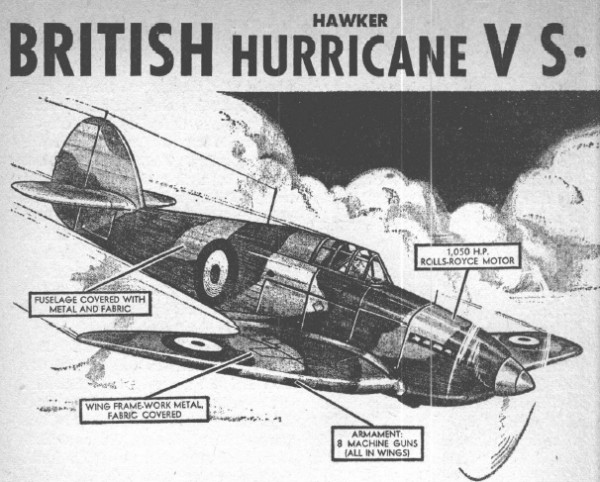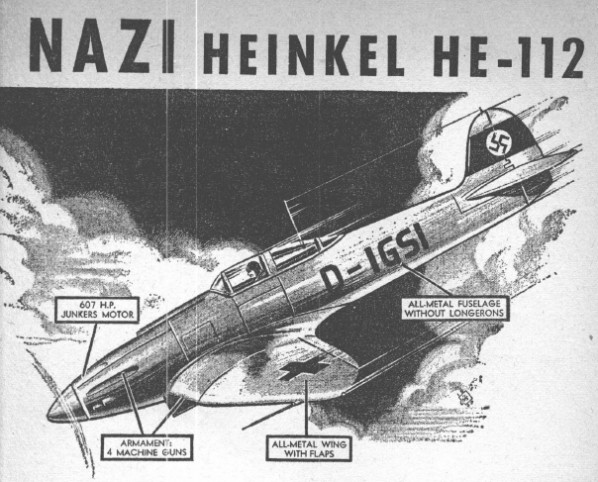
Help via Ko-Fi
THE battle that results when the British "Hawker Hurricane" meets Nazi Heinkel He-112 is swift and terrible. Both pilots have terrific speed, although the British ship is capable of about 17 miles per hour in excess of the Nazi plane. The battle between these two would take place at high altitude, since the Hurricane's pilot would climb to get above his opponent and dive clown upon him in lightning attack. In turn, the Heinkel's pilot would turn his ship swiftly to avoid the eight sputtering guns of the Hurricane, and climb. It is then his turn. He zooms to the attack with his own four guns spitting flame. But unless he gels in a death blow, he finds himself outmaneuvered. The British ship has more wing-surface and with his added speed. the Heinkel cannot get on the Britisher's tail. Having failed in his swift retaliation, the Nazi drops away, lets his load of bombs go, and streaks for home. His only salvation in this event is to cover enough distance to cause the Hurricane to abandon the chase, since the British ship cannot remain in the air more than two hours. The end of such a fight is either lightning death, or several futile thrusts and speedy flight.

SPECIFICATIONS
TYPE—Single seat fighter monoplane.
PERFORMANCE-Maximum speed 335 m.p.h. Climb to 20,000 ft. in 9 mins. Landing speed 62 m.p.h.
POWER PLANT—One Rolls-Royce "Merlin II" twelve-cylinder Vee liquid cooled engine rated at 990 h.p. at 12,000 feet and a maximum output of 1,050 h.p. at 16,000 it. Fixed-pitch wooden airscrew and now some come equipped with a controllable pitch propeller. Ducted radiator under fuselage below cockpit.
WINGS—Made of steel and aluminum-alloy framework fabric covered.
FUSELAGE—Rectangular structure of braced aluminum-alloy and steel. The forward part is covered with metal and rearward portions with fabric.
UNDERCARRIAGE— Retractable with two Dowty shock-absorber struts hinged at the extremities of the center-section from spar and retracted inward and slightly backward by Dowty hydraulic rams to bring wheels between spars when raised. Dunlop wheels and hydraulic brakes. Dowty retractable tail-wheel unit.
ARMAMENT—Eight machine-guns in wings, four on each side of fuselage firing outside disc swept by airscrew. Night-flying equipment with landing-lights in leading-edge of outer wing sections, navigation lights, oxygen equipment, radio, flare tubes.
DIMENSIONS—Span 40 ft., length 31 ft. 5 in., height 13 ft. 3 in., wing area 257.559 ft.
WEIGHTS—Weight loaded 6,000 lbs., wing loading 23.3 lbs., power loading 6.7 lbs. per h.p., range about 650 miles.

SPECIFICATIONS
TYPE—Single seat fighter monoplane.
PERFORMANCE—Maximum speed 316.7 m.p.h., climb to 3,280 ft. in 1.2 mins., range 2,110 miles.
POWER PLANT—One 670 h.p. Junkers "Juno 210G" twelve-cylinder inverted Vee water-cooled engine, driving a three-bladed constant speed propeller. Fuel tanks are in the center of the wing and the radiator is located directly below the engine.
WINGS—All-metal low-wing cantilever monoplane. Wing-roots swept up at their junctions with the fuselage. While trailing-edge hinged, the outer portions acting as ailerons and the inner portions as landing flaps.
FUSELAGE—Light metal monocoque (a fuselage without longitudinal members) the outer shell carrying most of the stresses.
UNDERCARRIAGE—Retractable type mounted on normal long-stroke oleo (oil shock absorber springs) legs. The retracting mechanism is worked hydraulically with oil. The wheels are providing with fainng plates which completely seal the weeks under the wings when retracted. A telltale indicator shows the position of the undercarriage at all times. Wheel breaks are provided. The oleo-sprung tail wheel also retracts.
ARMAMENT: Two fixed machine-guns in sides of fuselage and firing through propeller. Two automatic guns in wings outside of disc swept by propeller Racks for six 22 lb. bombs. Radio transmitting and receiving equipment.
DIMENSIONS—Span 30 ft. 2 in., length 29 ft. 6 in., height 12 ft., wing area 183 sq. ft.
WEIGHTS—Weight loaded 4,906 lbs.